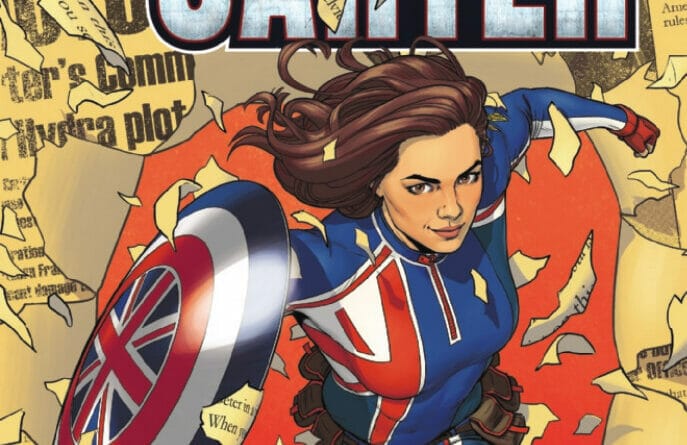*** WARNING SPOILERS AHEAD FOR CAPTAIN CARTER #1***
It’s been nearly a year since the premiere of Marvel Studios’ What If…? on Disney+. This episode saw Peggy Carter being injected with the Super Soldier serum, picking up the shield and becoming Captain Carter. The animated debut of Peggy Carter as Captain America/Captain Carter gained massive popularity. And now, Marvel Comics have latched onto Captain Carter’s newfound popularity and have published a limited series following her escapades in the modern-day. Captain Carter is a woman out of time, struggling to find her footing in this vastly more complicated age whilst everyone who’s anyone wants to get her on their side.
Writer Jamie McKelvie, penciler Marika Cresta, colorist Erick Arciniega, and letterer VC’s Clayton Cowles explore Peggy Carter’s journey to decide what she wants as everyone with an agenda try to tie her down. The question is, however, whether or not she has time to decide before mysterious forces start gunning for her once more. Although targeting the appeal of the What If series’ interpretation of the character works from a business standpoint, many comic fans were perplexed by this book’s announcement.
As there is a pre-existing version of Captain Carter that was introduced into the comics within the 2018 Exiles book by Saladin Ahmed which had already collected a decent following. Concerns on the erasure of this version are growing, as McKelvie’s take on the character seems entirely disconnected from the character introduced in Exiles.
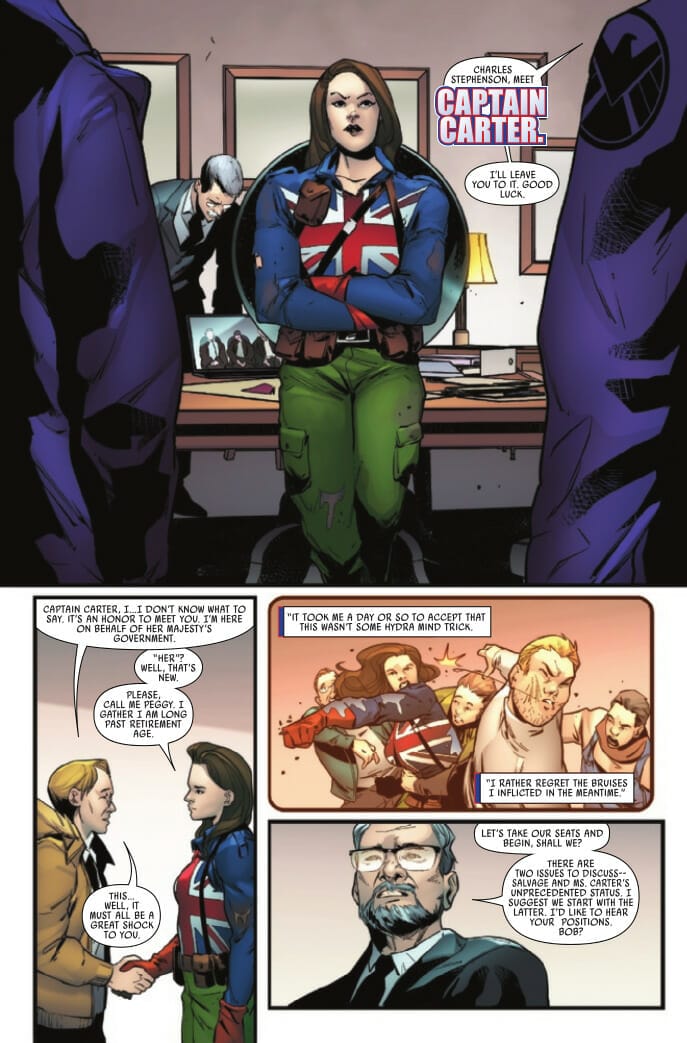


Similarly, readers of the Jonathan Hickman era of the X-Men books were led to expect that Betsy Braddock, the new Captain Britain, would be taking up a shield brandishing the Union Jack throughout the Knights of X series in April later this year. Overall, the reaction to this new Captain Carter variation has been shakey, to say the least.
Much like Steve Roger’s origin as Captain America, this opening issue explores Peggy’s experiences within the twenty-first century; technological advancements, government officials trying to order her around, and how she can live up to the legend surrounding her adventure’s throughout the second world war.
However, as this story takes place within an entirely new universe within Marvel Comics, McKelvie works to establish the players that are present throughout it aside from Peggy Carter. Specifically mentioned within this issue is the ‘Fantastic Five’, obviously this alternate universe’s version of the Fantastic Four. Through name-dropping groups and characters such as these, Mckelvie is teasing the possibility of their appearance. Therefore it entices fans of the characters to keep reading and see how their favorites have been changed to fit this new environment.
Throughout the majority of the book, Peggy is grappling with the idea of re-emerging as Great Britain’s premier superhero. Due to the state of shock that she finds herself in, Peggy is rather reluctant to take up her position as Captain Carter once again. However, Peggy is forced into the limelight when a group of Hydra followers attacks her whilst she’s riding on a public bus.
The inclusion of this action scene is the key moment of characterization for Peggy within this issue, and any character taking up the mantle of Captain America. Peggy prioritizes the safety of the civilians around her rather than the safety of her identity and own feelings, she pushes through her self-doubt with the goal of maintaining the greater good. Her narration throughout this action scene similarly assists with developing her sense of morality. Whilst Peggy is angry in this scene, her emotions are not fueled by any frustration from being forced to fight again but from the disgust, she feels towards the Hydra followers, who are going after civilians in order to get to her.
The action scene ends with Peggy capturing one of the Hydra followers, however, they take a cyanide pill before she can ask any questions. Although this action scene is short, the introduction of the mystery of why Peggy was attacked and how Hydra knows about her allows the reader to remain engaged to see how this conspiracy will unravel.
However, the action can be seen as rather minimal. Although establishing the personality and morality of new characters is important, especially within their first issue, some may take issue with its slight restrictions on Peggy’s character. The origin she is given is rather stable, a predictable retelling of the Captain America origin just set within Britain.
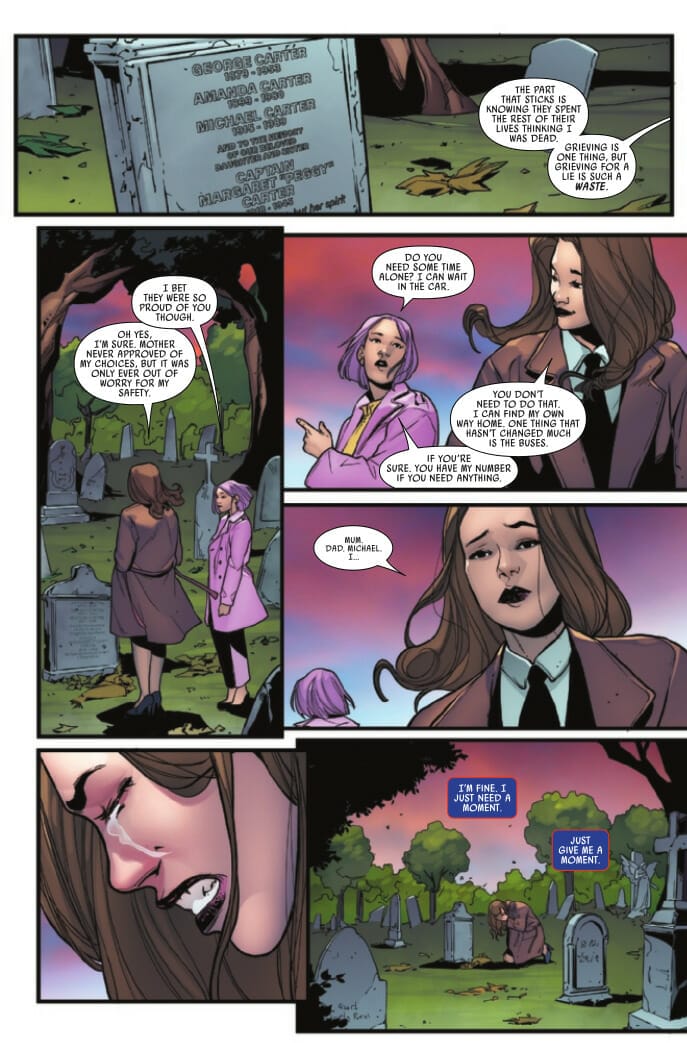
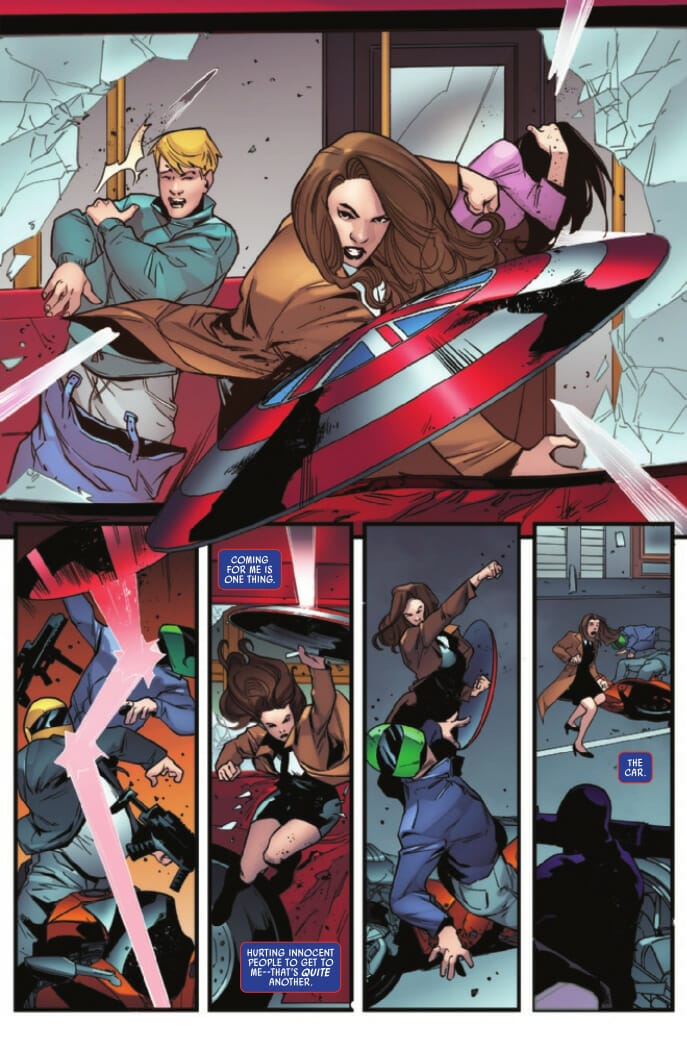
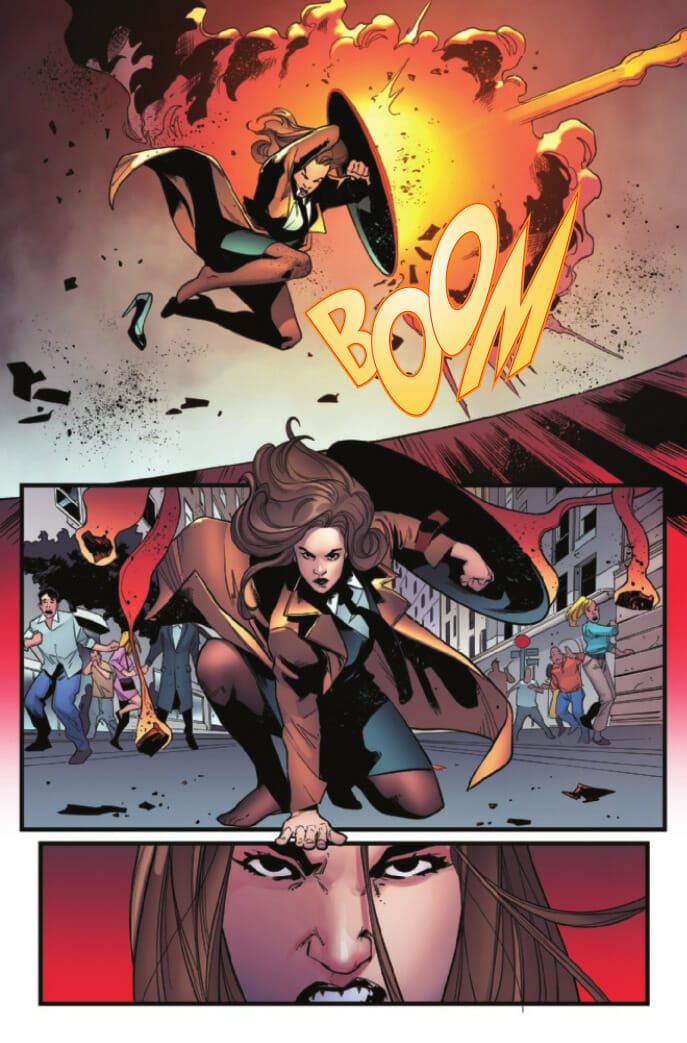
Another highlight of this issue’s action scene is the pencils by Marika Cresta. Up until this point, the book’s visuals have remained fairly subdued; whilst the drawings are high quality and well paneled, they were not allowed any opportunities to shine in a major way. Whilst the action isn’t on the grandest, the smaller scale allows the scene to be very matter-of-fact. The reader is allowed to remain close to Peggy and experience that carnage from her perspective.
The art of the book is complemented by Arciniega colorings. Whilst some of his colors can give the book a glossy effect, causing the characters to come off as plastic, he truly excels when it comes to effects and action. Due to his use of vibrant coloration and gradients, the action in this issue has a sense of flair and motion to them; the colors shift in shades and tones in correspondence to the movements of the characters from panel to panel, allowing for a sense of realism whilst having the action being visually intriguing.
Although the introduction of the new Captain Carter brought a mixed reaction from fans, Peggy’s character should be allowed exploration before we make assumptions. Captain Carter Issue One allows for some strong character moments and decent action. Unfortunately, her introduction was somewhat by the numbers, with her origins following the basic plot points of Steve Roger’s origin without a great sense of uniqueness.
However, the issue does work well to introduce the world Captain Carter will be entering into as the hero representing the British Isles, as it focuses on the smaller scale and teases that can be paid off later. On the same note, the action within this issue similarly follows the principal, McKelvie uses this minor action scene to have the reader stick close to Peggy and develop a further connection to her character and perspective. The implementation of a mystery allows readers to remain intrigued.
Captain Carter #1 is a fairly decent introduction to this new version of the character. Although it can be argued this book is heavily reliant on the popularity of the What If…? animated series, the introduction to this version of the character and this new universe seems to offer enough intrigue to keep people engaged and wanting to expand their knowledge. Alongside some solid visuals, this new Peggy Carter story offers a fun read that should hopefully make fans see her in a better light.
Want to discuss things further? Hit us up on Twitter, Facebook, or Instagram. For more film, gaming, anime, and comic book content; TV news, trailers, updates, and reviews, make sure to keep it locked right here at The Nerdy Basement. While you’re here, please consider supporting us on Patreon! It’s an easy way of supporting us so we can keep providing you with your Nerdy News!

